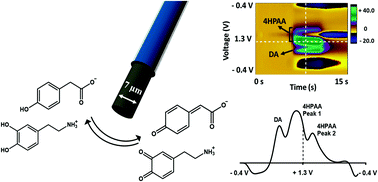Simultaneous measurement and quantitation of 4-hydroxyphenylacetic acid and dopamine with fast-scan cyclic voltammetry†
Abstract
Caged compounds have been used extensively to investigate neuronal function in a variety of preparations, including cell culture, ex vivo tissue samples, and in vivo. As a first step toward electrochemically measuring the extent of caged compound photoactivation while also measuring the release of the catecholamine neurotransmitter, dopamine, fast-scan cyclic voltammetry at carbon-fiber microelectrodes (FSCV) was used to electrochemically characterize 4-hydroxyphenylacetic acid (4HPAA) in the absence and presence of dopamine. 4HPAA is a by-product formed during the process of photoactivation of p-hydroxyphenacyl-based caged compounds, such as p-hydroxyphenylglutamate (pHP-Glu). Our data suggest that the oxidation of 4HPAA occurs through the formation of a conjugated species. Moreover, we found that a triangular waveform of −0.4 V to +1.3 V to −0.4 V at 600 V s−1, repeated every 100 ms, provided an oxidation current of 4HPAA that was enhanced with a limit of detection of 100 nM, while also allowing the detection and quantitation of dopamine within the same scan. Along with quantifying 4HPAA in biological preparations, the results from this work will allow the electrochemical measurement of photoactivation reactions that generate 4HPAA as a by-product as well as provide a framework for measuring the photorelease of electroactive by-products from caged compounds that incorporate other chromophores.


 Please wait while we load your content...
Please wait while we load your content...